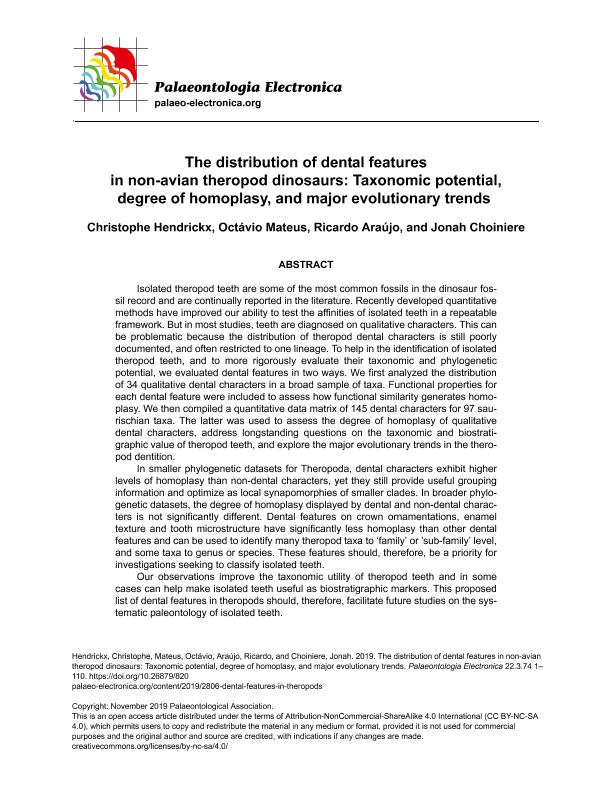Mostrar el registro sencillo del ítem
dc.contributor.author
Hendrickx, Christophe

dc.contributor.author
Mateus, Octávio
dc.contributor.author
Araujo, Ricardo
dc.contributor.author
Choiniere, Jonah N.
dc.date.available
2021-11-04T15:44:06Z
dc.date.issued
2019-11
dc.identifier.citation
Hendrickx, Christophe; Mateus, Octávio; Araujo, Ricardo; Choiniere, Jonah N.; The distribution of dental features in non-avian theropod dinosaurs: Taxonomic potential, degree of homoplasy, and major evolutionary trends; Coquina Press; Palaeontologia Electronica; 22; 3; 11-2019; 1-10
dc.identifier.issn
1532-3056
dc.identifier.uri
http://hdl.handle.net/11336/146011
dc.description.abstract
Isolated theropod teeth are some of the most common fossils in the dinosaur fossil record and are continually reported in the literature. Recently developed quantitative methods have improved our ability to test the affinities of isolated teeth in a repeatable framework. But in most studies, teeth are diagnosed on qualitative characters. This can be problematic because the distribution of theropod dental characters is still poorly documented, and often restricted to one lineage. To help in the identification of isolated theropod teeth, and to more rigorously evaluate their taxonomic and phylogenetic potential, we evaluated dental features in two ways. We first analyzed the distribution of 34 qualitative dental characters in a broad sample of taxa. Functional properties for each dental feature were included to assess how functional similarity generates homoplasy. We then compiled a quantitative data matrix of 145 dental characters for 97 saurischian taxa. The latter was used to assess the degree of homoplasy of qualitative dental characters, address longstanding questions on the taxonomic and biostratigraphic value of theropod teeth, and explore the major evolutionary trends in the theropod dentition. In smaller phylogenetic datasets for Theropoda, dental characters exhibit higher levels of homoplasy than non-dental characters, yet they still provide useful grouping information and optimize as local synapomorphies of smaller clades. In broader phylogenetic datasets, the degree of homoplasy displayed by dental and non-dental characters is not significantly different. Dental features on crown ornamentations, enamel texture and tooth microstructure have significantly less homoplasy than other dental features and can be used to identify many theropod taxa to ‘family’ or ’sub-family’ level, and some taxa to genus or species. These features should, therefore, be a priority for investigations seeking to classify isolated teeth. Our observations improve the taxonomic utility of theropod teeth and in some cases can help make isolated teeth useful as biostratigraphic markers. This proposed list of dental features in theropods should, therefore, facilitate future studies on the systematic paleontology of isolated teeth.
dc.format
application/pdf
dc.language.iso
eng
dc.publisher
Coquina Press

dc.rights
info:eu-repo/semantics/openAccess
dc.rights.uri
https://creativecommons.org/licenses/by-nc-sa/2.5/ar/
dc.subject
EVOLUTION
dc.subject
FUNCTION
dc.subject
TEETH
dc.subject.classification
Paleontología

dc.subject.classification
Ciencias de la Tierra y relacionadas con el Medio Ambiente

dc.subject.classification
CIENCIAS NATURALES Y EXACTAS

dc.title
The distribution of dental features in non-avian theropod dinosaurs: Taxonomic potential, degree of homoplasy, and major evolutionary trends
dc.type
info:eu-repo/semantics/article
dc.type
info:ar-repo/semantics/artículo
dc.type
info:eu-repo/semantics/publishedVersion
dc.date.updated
2020-12-16T16:08:25Z
dc.journal.volume
22
dc.journal.number
3
dc.journal.pagination
1-10
dc.journal.pais
Estados Unidos

dc.journal.ciudad
New York
dc.description.fil
Fil: Hendrickx, Christophe. University of the Witwatersrand; Sudáfrica. Consejo Nacional de Investigaciones Científicas y Técnicas. Centro Científico Tecnológico - Tucumán. Unidad Ejecutora Lillo; Argentina
dc.description.fil
Fil: Mateus, Octávio. Universidade Nova de Lisboa; Portugal
dc.description.fil
Fil: Araujo, Ricardo. Southern Methodist University; Estados Unidos
dc.description.fil
Fil: Choiniere, Jonah N.. University of the Witwatersrand; Sudáfrica
dc.journal.title
Palaeontologia Electronica

dc.relation.alternativeid
info:eu-repo/semantics/altIdentifier/url/https://palaeo-electronica.org/content/pdfs/820.pdf
dc.relation.alternativeid
info:eu-repo/semantics/altIdentifier/doi/https://doi.org/10.26879/820
Archivos asociados
